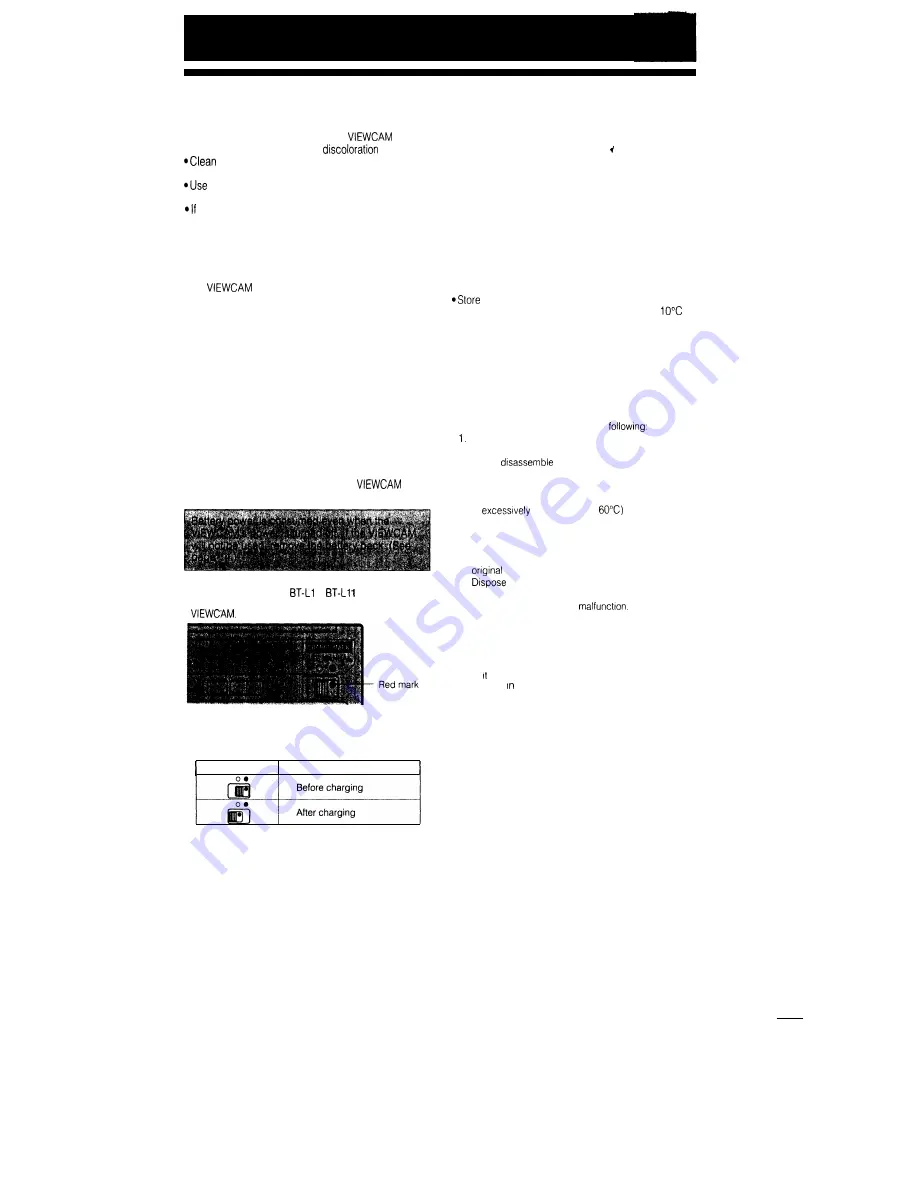
CARE
Cleaning and maintenance
*Many plastic parts are used in the
casing. Do not use thinners, benzenes or other strong chemical
cleaners. These may cause
and damage to the casing.
the casing with a soft, dry cloth. If the casing is particularly dirty, wipe the casing with a tightly wrung
cloth dampened with a diluted, neutral detergent. Then wipe it again with a soft, dry cloth.
the supplied cleaning cloth to wipe finger marks and other soiling off the LCD monitor and lens
protector. Or, use the optional cleaning kit to clean the lens protector even better.
the lens needs cleaning, first remove the lens protector by turning it anti-clockwise. Then clean the lens
with the supplied cleaning cloth, the optional cleaning kit, or compressed air and lens papers designed for
photographic lenses.
BATTERY PACK
This
uses a lithium-ion type battery pack.
It is not necessary to store the lithium-ion battery
pack in a full-discharged state. Also, if stored in the
charged state, the battery will self-discharge
naturally, resulting in decrease recording time.
Charge the battery pack soon (a day) before use.
Battery pack consumption
l
Recording with many starts and stops, frequent
zooming, and recording in low temperatures will
somewhat shorten actual recording times.
Accordingly, be sure to turn off the power when not
recording. Use of an auxiliary battery pack is
recommended to prevent undesirable interruptions
in your recording.
l
Do not use an insufficiently charged or weak
battery pack. Such battery packs may cause the
power to automatically stop during
operation.
Note:
Please use the SHARP
or
battery packs.
They are designed specifically for use with this
How to use the marker on the battery pack
The marker is provided to indicate the battery’s
charge condition. Slide the switch to indicate the
battery charge condition as follows:
Position
Charge conditions
Temperature during charging
the battery pack in a dry, cool place.
l
Charge the battery pack at temperature of
to
30°C.
For long battery lifetime
*Charge the battery pack (lithium-ion type) at least
once every six months.
l
Do not leave the battery pack being charged for
long periods of time.
Cautions:
l
If the battery pack is misused, there is danger of fire or
explosion. Pay close attention to the
2.
3.
4.
5.
6.
7.
8.
9.
Do not dispose of in fire.
Do not short-circuit the terminal by metallic contact.
Do not
or repair yourself.
Do not use any battery charger other than those
designed for this battery pack.
Do not place the battery pack under direct sunlight or
in
hot places (over
such as the
dash board of cars.
Do not expose to moisture, water or sea water.
Do not drop or subject to strong force
Keep the battery pack out of reach of children and in
package until ready to use.
of used batteries promptly.
l
The battery pack will become warm during charging and
use. This
IS
normal and not a
l
The battery pack has a limited service life. If the period of
use becomes noticeably shorter with a normal charge,
this indicates the end of the battery pack’s service life.
Replace it with a new battery pack.
l
For safety, keep the battery pack in its protective cover
when is not being used. If the metal parts of the battery
pack come contact with other metal items, there
IS
a
danger that a short circuit may occur.
. Do not carry the battery in your pocket or a bag together
with metal objects (keys, coins, jewelry, etc).
l
Do not insert objects (metal etc.) into the battery
compartment of this product or into the rechargeable
battery.
Do not get the terminals dirty If the rechargeable
terminals are dirty, the operating time may be shortened
or it may not be possible to charge the battery.
4







































